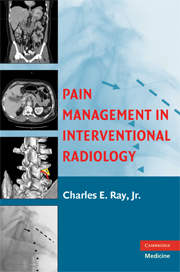Book contents
- Frontmatter
- Contents
- Contributors
- Preface
- Acknowledgments
- 1 Pain Management in Interventional Radiology: An Introduction
- 2 Clinical Evaluation of Low-Back Pain
- PART I LOCOREGIONAL PAIN CONTROL
- PART II SYSTEMIC PAIN CONTROL
- 16 Sedation and Analgesia Medications
- 17 Guidelines for Sedation Administered by Nonanesthesiologists
- 18 Pediatric Sedation for Radiological Imaging Studies and Interventions
- 19 Nontraditional Pain Management in Interventional Radiology
- 20 Postprocedural Pain Control
- Index
- References
16 - Sedation and Analgesia Medications
from PART II - SYSTEMIC PAIN CONTROL
Published online by Cambridge University Press: 04 September 2009
- Frontmatter
- Contents
- Contributors
- Preface
- Acknowledgments
- 1 Pain Management in Interventional Radiology: An Introduction
- 2 Clinical Evaluation of Low-Back Pain
- PART I LOCOREGIONAL PAIN CONTROL
- PART II SYSTEMIC PAIN CONTROL
- 16 Sedation and Analgesia Medications
- 17 Guidelines for Sedation Administered by Nonanesthesiologists
- 18 Pediatric Sedation for Radiological Imaging Studies and Interventions
- 19 Nontraditional Pain Management in Interventional Radiology
- 20 Postprocedural Pain Control
- Index
- References
Summary
INTRODUCTION
The performance of minimally invasive interventional radiology procedures has increased in a significant fashion over the past 20 years. The trend in modern medicine has definitely moved toward solving medical problems with minimally invasive techniques. This trend toward minimally invasive techniques has made it extremely important for the interventionalist to be able to provide adequate sedation and analgesia during interventional procedures. Providing effective and safe sedation and analgesia has become part of the standards of care for any interventional radiology practice.
Selected patients undergoing very simple procedures may not require any sedation or analgesia; however, most of the therapeutic procedures currently performed in interventional radiology suites require the patient to be under moderate sedation and analgesia, which is also known as “conscious sedation” or, more appropriately, “sedation and analgesia.”
The purpose of this chapter is to provide an overview of the most important components of sedation that an interventional radiologist should know about sedation and analgesia. The chapter will address the use of medications, mechanisms of action, doses, and antagonists, as well as the appropriate ways to monitor the patient.
DEFINITIONS
The terms sedation and analgesia refer to a fluctuant state of conscious depression induced by pharmacological agents (1). In 2002, the American Society of Anesthesiologists (ASA) published well-defined guidelines for sedation and analgesia by nonanesthesiologists. The document specifies the spectrum of sedation/analgesia and provides qualitative parameters for the classification of stages of sedation (Table 1).
- Type
- Chapter
- Information
- Pain Management in Interventional Radiology , pp. 241 - 259Publisher: Cambridge University PressPrint publication year: 2008



